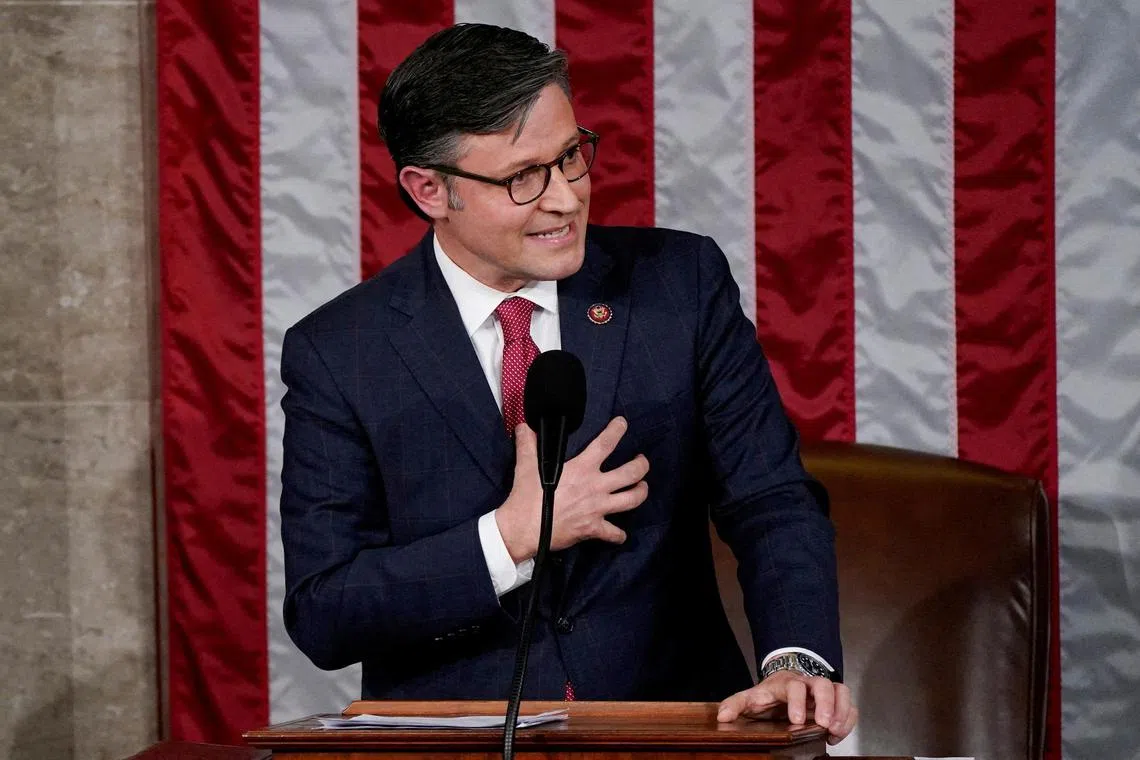US House speaker's plan to avoid shutdown gains some Democratic support
Sign up now: Get ST's newsletters delivered to your inbox

Speaker of the House Mike Johnson addresses the US House of Representatives after he was elected to be the new Speaker in Oct 2023.
PHOTO: REUTERS
Follow topic:
WASHINGTON - US House of Representatives Speaker Mike Johnson’s plan to avoid a partial government shutdown
Senate Majority Leader Schumer, whose support would be critical to pass the measure to head off a government shutdown beginning on Saturday, said he was “pleased” that Mr Johnson’s proposal did not include sharp spending cuts.
“The speaker’s proposal is far from perfect, but the most important thing is it refrains from making steep cuts,” said Mr Schumer, who stopped short of backing the idea.
However, before the bill can move to the Senate, it will need to clear the House, where at least seven of Mr Johnson’s fellow Republican signalled opposition to his two-step continuing resolution, or “CR”, which would keep federal agencies operating at current funding levels.
Representative Chip Roy, a prominent hardliner, blasted the measure for its absence of spending cuts and conservative policies, and because it would extend food assistance for poor families to Sept. 30. Without changes, the Texas Republican said he would oppose efforts to bring the bill to the floor.
“We got nothing - nothing,” Mr Roy told reporters. “I’m certainly talking to my colleagues about our concerns. And I certainly hope that this bill is not going to proceed as it’s currently structured.”
Top House Democrat Hakeem Jeffries said he was “carefully evaluating” Mr Johnson’s proposal.
Despite an unusual structure that sets different funding deadlines for different parts of the government, Mr Johnson’s CR amounts to a “clean” bill without spending cuts, policy provisions or other strings attached - the kind of measure that led to the historic ouster of his predecessor, Kevin McCarthy, by his right flank.
Congress is engaged in its third fiscal showdown this year, following a months-long spring standoff over the nation’s more than US$31 trillion (S$42 trillion) in debt, which brought the federal government to the brink of default.
The ongoing partisan gridlock, accentuated by fractures within the narrow 221-212 House Republican majority, led Moody’s late on Friday to lower its US credit rating outlook to “negative” from “stable,” as it noted that high interest rates would continue to drive borrowing costs higher. The nation’s deficit hit US$1.695 trillion in the fiscal year ended Sept 30.
The plan would need to pass the Democratic-majority Senate and be signed into law by President Joe Biden by midnight on Friday to avoid disrupting pay for up to four million federal workers, shuttering national parks and hobbling everything from financial oversight to scientific research.
‘Clean’ bill
Mr Johnson’s plan seems geared to find support from two warring Republican factions: hardliners who wanted different funding deadlines for different federal agencies and centrists who called for a “clean” vehicle without spending cuts or conservative policy riders that Democrats would reject.
His bill would extend funding for military construction, veterans benefits, transportation, housing, urban development, agriculture, the Food and Drug Administration and energy and water programs through Jan 19. Funding for all other federal operations, including defence, would expire on Feb 2.
The bill is intended to pressure the House and Senate to agree on spending bills for fiscal 2024 by the assigned dates. Mr Johnson warned Democrats that House Republicans would impose a full-year CR for 2024 “with appropriate adjustments to meet our national security priorities” if Congress fails to reach agreement on full-year spending.
The approach quickly came under fire from the White House and members of both parties.
Among hardliners in opposition, Good was joined by Representatives Marjorie Taylor Greene, Warren Davidson, Scott Perry, Andrew Clyde and Chip Roy. Indicted Republican George Santos also said he would not back it.
“I will not support a status quo that fails to acknowledge fiscal irresponsibility, and changes absolutely nothing while emboldening a do-nothing Senate and a fiscally illiterate President,” said Mr Perry, who chairs the ultraconservative House Freedom Caucus, on the X social media platform.
The White House over the weekend blasted the plan as chaotic, but there were also indications that it could provide a path forward for Congress, given Mr Johnson’s decision to assign defence spending to Feb 2. Democrats had worried that Republicans would put defence and other party priorities in the first tranche and then let the remaining programs shut down.
“This latest proposal is very much untested,” said White House spokesman Karine Jean-Pierre said on Monday, adding that they would watch lawmakers negotiations play out.
Benchmark of success
House Republicans are aiming for a Tuesday vote. But it is unclear whether their conference, which has spent the past 10 months at war with itself over spending and culture war issues, can muster the 217 votes needed to pass the measure without Democratic support, which many Republicans view as the benchmark of success.
Failure to hit that benchmark led to Mr McCarthy’s ouster, but some House Republicans suggested Mr Johnson deserved more time.
The brutal infighting among Republicans this year, including the party’s own rejection of three seasoned nominees for House speaker, coincides with falling federal revenues and mounting costs for interest, health and pension outlays.
Lawmakers are at odds over discretionary spending for fiscal 2024. Democrats and many Republicans want to stick to the US$1.59 trillion level that Mr Biden and Mr McCarthy set in their debt ceiling agreement earlier this year. Hardliners have pushed for a figure US$120 billion lower. In recent days, they have signalled a net willingness to compromise.
But the political fracas is focused on just a fraction of the total US budget, which also includes mandatory outlays for Social Security and Medicare. Total US spending topped US$6.1 trillion in fiscal 2023. REUTERS

